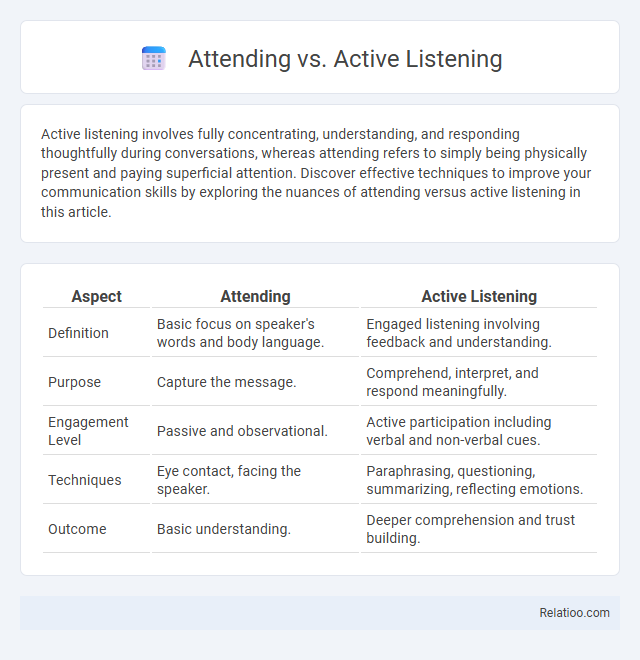Active listening involves fully concentrating, understanding, and responding thoughtfully during conversations, whereas attending refers to simply being physically present and paying superficial attention. Discover effective techniques to improve your communication skills by exploring the nuances of attending versus active listening in this article.
Table of Comparison
| Aspect | Attending | Active Listening |
|---|---|---|
| Definition | Basic focus on speaker's words and body language. | Engaged listening involving feedback and understanding. |
| Purpose | Capture the message. | Comprehend, interpret, and respond meaningfully. |
| Engagement Level | Passive and observational. | Active participation including verbal and non-verbal cues. |
| Techniques | Eye contact, facing the speaker. | Paraphrasing, questioning, summarizing, reflecting emotions. |
| Outcome | Basic understanding. | Deeper comprehension and trust building. |
Introduction to Attending and Active Listening
Attending involves fully focusing on the speaker through nonverbal cues like eye contact and body orientation, which signals your complete presence and engagement. Active listening goes beyond attending by incorporating verbal feedback, paraphrasing, and asking clarifying questions to ensure accurate understanding and empathy. Your ability to combine attending and active listening enhances communication effectiveness and strengthens interpersonal connections.
Defining Attending: The Foundation of Communication
Attending is the fundamental skill in communication that involves fully focusing your attention on the speaker's verbal and non-verbal cues, ensuring you are present both mentally and physically. Active listening builds on attending by engaging with the speaker through feedback, clarification, and empathetic responses that deepen understanding. Mastering attending establishes a strong foundation for effective communication, enabling Your interactions to be more meaningful and connected.
Active Listening: Going Beyond Hearing
Active listening surpasses mere attending by involving full mental engagement and emotional understanding of the speaker's message. It requires focusing on verbal and non-verbal cues, providing feedback, and interpreting underlying meanings to foster effective communication. This skill enhances interpersonal relationships and conflict resolution by ensuring messages are truly comprehended rather than passively heard.
Key Differences Between Attending and Active Listening
Attending involves the physical and psychological presence focused on the speaker, such as maintaining eye contact and open body language, while active listening requires fully engaging with the message by interpreting, responding, and providing feedback. The key difference lies in attending as the initial step of being present, whereas active listening encompasses deeper cognitive processes, including understanding and empathizing with the speaker's content. Active listening also includes paraphrasing and questioning to clarify meaning, going beyond simply attending to capture the speaker's intent accurately.
The Role of Body Language in Attending
Body language plays a crucial role in attending by conveying genuine interest and engagement without interrupting the speaker. Effective attending involves maintaining eye contact, nodding, and open posture to signal attentiveness and encourage communication. These nonverbal cues enhance active listening by reinforcing understanding and fostering a connection between the speaker and listener.
Techniques for Practicing Active Listening
Active listening involves fully concentrating, understanding, and responding thoughtfully to the speaker, which is more engaged than basic attending that only requires being physically present. Techniques for practicing active listening include maintaining eye contact, nodding to show understanding, paraphrasing key points, and asking clarifying questions to ensure comprehension. Your ability to use these methods enhances communication by fostering trust and reducing misunderstandings during conversations.
Benefits of Effective Attending Skills
Effective attending skills enhance your ability to fully engage with speakers, improving comprehension and retention of information. These skills foster deeper connections by demonstrating respect and empathy, which builds trust and encourages open communication. Mastering effective attending leads to better problem-solving and collaboration in both personal and professional settings.
Advantages of Active Listening in Relationships
Active listening deepens emotional connections by ensuring you fully understand your partner's feelings and perspectives, fostering trust and empathy. Unlike passive attending, active listening encourages meaningful dialogue and reduces misunderstandings, strengthening the foundation of your relationship. This engaged communication approach enhances conflict resolution and promotes long-term relational satisfaction.
Common Barriers to Attending and Active Listening
Common barriers to attending and active listening include distractions, preconceived notions, and emotional biases that hinder full engagement with the speaker. Physical factors such as noise, fatigue, and environmental discomfort also reduce the ability to focus attention effectively. Overcoming these obstacles requires intentional mindfulness, clear communication signals, and eliminating external disturbances to enhance comprehension and connection.
Practical Tips for Enhancing Communication Skills
Effective communication hinges on mastering attending, active listening, and focused attending techniques. Practical tips include maintaining eye contact, minimizing distractions, and providing verbal and non-verbal feedback to demonstrate engagement. Regularly summarizing key points and asking clarifying questions enhance understanding and foster meaningful interactions.

Infographic: Attending vs Active Listening
 relatioo.com
relatioo.com